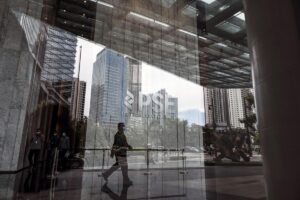Philippine Stocks Slide into Bear Market: Analyzing the Trend and Implications
The Philippine stock market is facing considerable challenges, marking its fifth consecutive day of declines and officially entering bear market territory. As the benchmark index plummets, both domestic and global economic factors are coming into play, and understanding these nuances is crucial for investors.
Key Trends in the Market
The Philippine Stock Exchange Index closed down 4% at 5,862.59, representing a staggering 20% drop from its peak in October and reaching its lowest point since October 2022. This decline has raised alarms among market watchers, as this is the first time in over two years that the market has dipped to such levels. The day’s trading was marked by increased activity, with 138.8 million shares exchanging hands—the highest daily turnover in the past four months—indicating heightened investor anxiety.
Economic Data Raises Concerns
Recent economic reports have also contributed to the bearish sentiment. The Philippines’ gross domestic product (GDP) growth was measured at 5.2% for the last quarter, which disappointed analysts who had expected a growth rate of 5.5%. This stagnation was primarily driven by sluggish investment, weak consumer spending, and unimpressive agricultural output. Such performance can understandably discourage investor confidence, particularly when juxtaposed against the buoyant growth figures of neighboring Southeast Asian economies.
Rastine Mackie Mercado, an analyst with Chinabank Securities in Manila, noted that "the bout of continuing weakness is likely being underpinned by the lack of a positive catalyst." This sentiment resonates with many investors who are adopting a watchful approach, as they await the full-year earnings releases of various companies.
External Factors at Play
Adding to the uncertainty are global economic conditions, particularly concerns surrounding potential higher tariffs from the United States under the Trump administration. The ripple effects from international policies inevitably impact the Philippine market, emphasizing the interconnectedness of today’s global economy. As markets worldwide react to foreign policy shifts, investors in the Philippines face compounded risks.
Major Stock Movements
The current market landscape has seen significant stock movements. Notably, San Miguel Corp. and Alliance Global Group Inc. both suffered a striking 20% drop, hitting their lowest levels in several years. This reflects a broader struggle within the 30-company benchmark index, where nearly all but two companies experienced declines.
Claire Alviar, an analyst at Philstocks Financial, pointed out that the "weaker-than-expected Philippine economic growth disappointed investors." The lack of clarity about President Trump’s policy directions further exacerbates these challenges, leaving many wary of making new investments.
Final Thoughts
As the Philippine stock market grapples with a myriad of local and global pressures, investors must maintain a vigilant approach. While current bearish conditions present a grim picture, they also unveil opportunities for those willing to engage with the complexities of market dynamics.
At Extreme Investor Network, we believe in the power of informed investing. By staying abreast of macroeconomic trends, understanding sectoral vulnerabilities, and evaluating company performances with a discerning eye, investors can position themselves to navigate even the most turbulent waters of the financial markets. Investors should consider diversifying their portfolios and looking for long-term growth potential amidst short-term volatility to capitalize on emerging opportunities.

